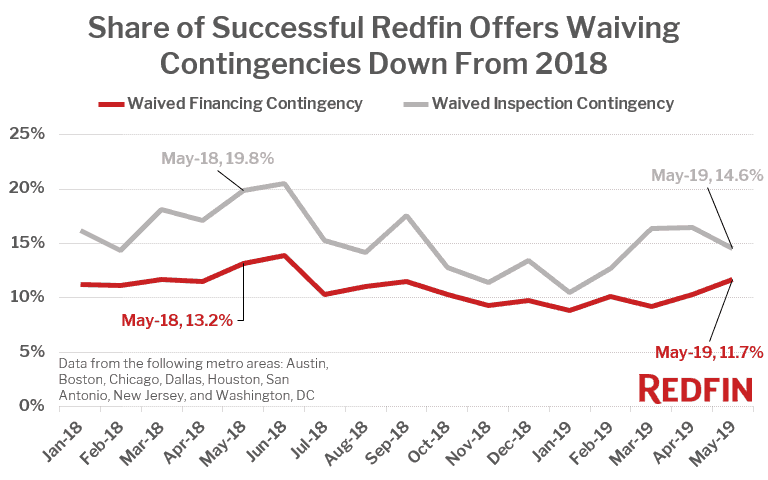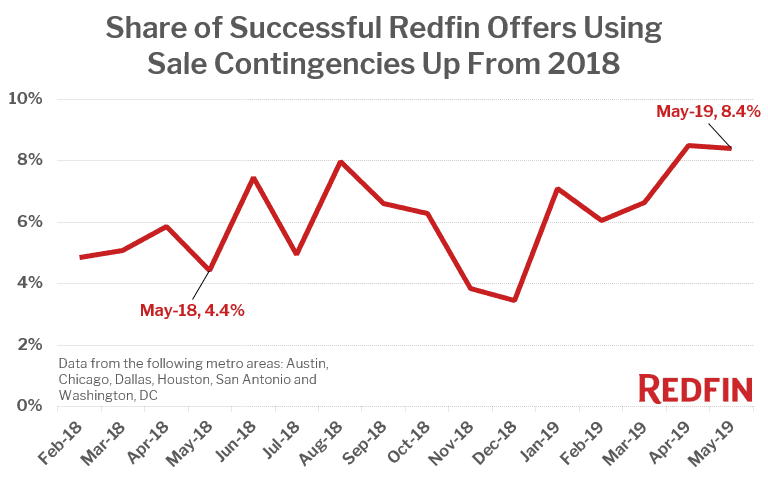Home-sale, financing, and inspection contingencies are all on the rise from a year ago.
Although the housing market is beginning to heat back up this spring, fewer buyers waived financing and inspection contingencies in May than a year earlier. In May, 14.6 percent of successful offers submitted by Redfin agents waived the inspection contingency, down from 19.8 percent a year earlier. Meanwhile, 11.7 percent of successful offers in May waived the financing contingency, down from 13.2 percent a year prior.
Waiving the inspection and financing contingencies are common strategies buyers use to make their offers more competitive by ensuring the seller that the deal will close and close on time without unforeseen hangups and negotiations. The inspection contingency allows the buyer to cancel the deal if they find an issue during the inspection period that they consider to be a deal-breaker. A financing contingency allows the buyer to cancel their purchase agreement if their financing falls through, for example if the appraisal comes in below the purchase price or the buyer’s finances change before closing. These contingencies are built into standard home purchase agreements as protections for the buyer, so waiving them gives the seller more control and assurance.
The fact that a shrinking share of successful offers waive these contingencies shows shows that buyers this year are able to be more judicious in their offers than they were last year.
“Sellers are more willing to give buyers what they want because sellers don’t have as much negotiating power as they did a year ago,” said Redfin chief economist Daryl Fairweather. “Last year, sellers would often receive multiple offers and had their pick of the litter. Now that they have less control of the market, sellers are taking on more of the risk from the buyer — like the risk that the buyer can’t sell her own home, or the risk that something unnerving is found during the inspection.”

Although these measures are lower than they were a year ago, they have both been trending up since January. This coincides with the overall market heating back up this spring as bidding wars have begun to climb slightly and we’ve seen the return of price increases and a slowdown in the growth of homes for sale.
In addition to financing and inspection contingencies, the use of home-sale contingencies (used by buyers who need to sell their own home in order to buy a new one) is also on the rise. In May, 8.4 percent of successful offers submitted by Redfin agents (as in, offers that were accepted by sellers) included a home-sale contingency, up from just 4.4 percent a year earlier and down just slightly from 8.5 percent in April, which was the highest level since we began recording this data.

A home-sale contingency makes the buyer’s offer contingent on the sale of their previous home. It’s not a standard component of most offers the way that inspection and financing contingencies are, but it is a way of allowing the buyer to coordinate the timing of the sale of their previous home with the purchase of their new home and to ensure they will have the funds available to close on their new home without having to carry two mortgages at once.
“Typically a seller won’t even consider an offer with a home-sale contingency during the first week or two that the home is on the market,” said Chicago-area Redfin agent Glenn Rickel. “If the buyer is not already under contract with the home they have to sell, they’re asking a big favor of the seller to take their home off the market for two months or more and hope that the buyer’s home sale goes through smoothly. Now that more homes are taking longer to sell, it’s become easier for a move-up buyer to find a home that has been on the market for a few weeks or a few months, which makes the seller a lot more likely to accept an offer with a home-sale contingency.”
Methodology
Data on offer contingencies is collected with a proprietary tool available to Redfin agents in select markets to enable them to quickly and easily complete offer paperwork for customers via their smartphone. The tool has been in use for over a year in all of the metro areas measured (Austin, Boston, Chicago, Dallas, Houston, San Antonio, New Jersey and Washington, D.C.).
Source – Redfin


